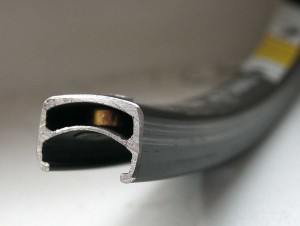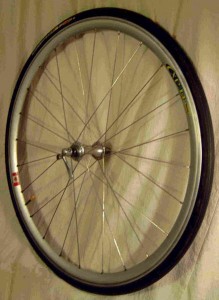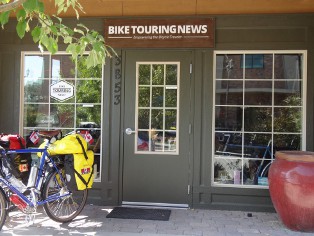What makes a good wheelset for loaded bicycle touring? Durability will probably rate high in any list of desirable attributes. So, what makes a bicycle wheel durable?
Rims:
An extruded aluminum double wall rim with a box section for strength. Drilled for 32 or 36 spokes with eyelets in the spoke holes. Eyelets can help distribute stresses and prevent galling of the metal where the spoke nipples rest. My personal favorite rims are Mavic CXP33 because they have a socket attached to the eyelet which distributes load to both walls of the rim. Another consideration when choosing a rim should be the width of the tire to be used. Schwalbe, the tire manufacturer addresses that on their website.
Spokes:
Spokes are normally made of stainless steel and are of uniform thickness the entire length (straight gauge) or are swaged to be skinnier in the middle (double or triple butted). Counterintuitively, double butted spokes are a better choice for durable wheels for a number of reasons. The skinny part is made skinny by drawing that section of the spoke through a reducing die which increases it’s strength by work hardening. The swaged spoke is more elastic and absorbs the stresses in the mid section rather than concentrating it in the elbows and threads. The third advantage requires a discussion of lacing patterns.
A “3-cross” lacing pattern means that any one spoke will cross over three other spokes on it’s way from the rim to the hub. Actually it will cross over two and under one. Without going into a lot of detail (mostly because I would probably get it wrong) the stresses induced in a spoke when the wheel goes around under the rider and load are in that way shared by more spokes. Swaged or double butted spokes do a better job of sharing this stress than straight gauge spokes by their virtue of being more resilient – they flex more.
Hubs:
Hubs must carry the individual spokes and be strong enough for the combined force of all the spokes in a finished wheel, a force that can equal a half ton in a 36 spoke wheel. Hubs can use loose bearings or cartridge bearings with benefits and drawbacks to both. An oversize and/or steel axle can be stronger for load carrying than a smaller alloy axle. As a generalization, most manufacturers will turn to aluminum or other exotic materials in their quest for lightweight in the upper end range, so it might be better for the touring cyclist to actually buy the less expensive models if they use more robust and durable materials.
Wheels can fail from sudden loads, such as in a crash, or running into an immovable object, or from fatigue. Rims can be abraded by sand and road grit imbedded in the brake pads, and can eventually fail when the force of the inflated tire breaks the wall of the rim. Rear wheels carry more weight and receive more stress because of the rigidity of the rear triangle.
Most spokes will fail at the elbow where they enter the hub due to fatigue. A properly built and tensioned wheel laced in a three cross pattern can reduce the risk of fatigue failure.
Many new bikes come with original equipment wheels that look light and fast because they only have a few spokes and aerodynamic rims. However, semi-aerodynamic and aerodynamic wheelsets tend to be heavier than more traditional spoked wheelsets due to the extra shapings of the rims and spokes. More important, the rims must be heavier when there are fewer spokes, as the unsupported span between spokes is greater.
I borrowed heavily for this post from the book The Bicycle Wheel by Jobst Brandt. If you want more about the theory behind the spoked bicycle wheel and want to have a go at building your own wheels, this book is a must.
The late, great Sheldon Brown’s site is an encyclopedia of all thing bikey, and this page tells how to lace a wheel.



TRIK3R December 4, 2011, 8:58 am
Being a fat boy, I’ve always used 40 hole rims, 14 ga. db spokes, 30+mm. tires and P.Wood hubs. Never broke a spoke on tour in over 35 years.
Bike Hermit December 4, 2011, 10:18 am
TRIK3R,
Thanks for the feedback. You better knock on wood though! I’m curious as to what diameter wheels you use and what spoke crossing pattern, 3 or 4?